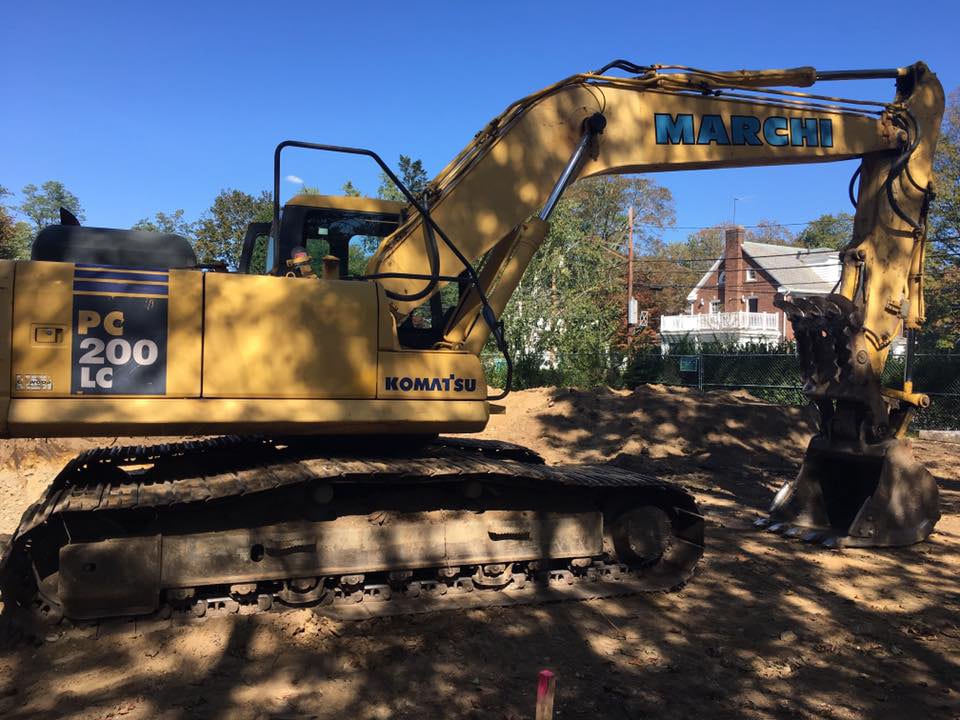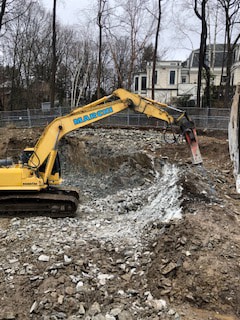Cost to Replace 50 Feet of Sewer Line: Top Factors in 2024
Understanding the Cost to Replace 50 Feet of Sewer Line
Replacing 50 feet of sewer line can be a costly endeavor, typically ranging from $3,000 to $15,000. The cost depends on various factors like the type of materials used, accessibility of the pipe, and whether you choose traditional or trenchless methods.
Timely replacement of a sewer line is crucial to prevent further damage and skyrocketing repair costs. Ignoring warning signs like standing water, slow drains, or foul odors could lead to more severe issues, such as sewage backups or extensive property damage. Early intervention can save homeowners thousands of dollars and provide peace of mind.
At Marchi Paving Inc., we specialize in providing reliable and high-quality sewer line replacement services. Our expert team understands the complexities involved in such projects and offers efficient, cost-effective solutions custom to your needs. Whether you’re a homeowner dealing with worn-out plumbing or a property manager trying to maintain safe and accessible facilities, we’ve got you covered.

Simple guide to cost to replace 50 feet of sewer line words:
– sewage line
– sewage pipes
What is Sewer Line Replacement?
Sewer line replacement is the process of removing an old, damaged sewer line and installing a new one to restore proper plumbing flow. This is often necessary when pipes have degraded over time or have been damaged by external factors like tree roots or shifting soil.
The Process
Replacing a sewer line involves several key steps:
- Inspection and Diagnosis:
- A professional plumber will first inspect the sewer line, often using a camera, to identify the exact location and extent of the damage.
- Trench Digging:
- Traditional sewer line replacement requires digging a trench to access the damaged pipe. This trench can be located in your yard, driveway, or basement, depending on where the pipe runs.
- Removing the Old Pipe:
- Once the trench is dug, the old, damaged pipe is carefully removed.
- Installing the New Pipe:
- A new pipe is then installed in place of the old one. The type of pipe used can vary, but common materials include PVC, copper, and cast iron.
- Backfilling and Restoration:
- After the new pipe is installed, the trench is backfilled with soil, and any disrupted landscaping or concrete is restored.
Trench Digging
Digging a trench is a labor-intensive part of sewer line replacement. This process involves:
- Excavating the Ground: Contractors use heavy machinery to dig a trench to the depth required to access the sewer line. The depth can vary, but it typically ranges from 18 inches to 6 feet, depending on local building codes and climate conditions.
- Handling Obstacles: If your yard has concrete slabs, patios, or large trees, these obstacles must be removed or worked around, adding to the complexity and cost of the project.
Pipe Installation
Once the old pipe is removed, the new pipe is installed:
- Choosing the Right Material: The choice of pipe material affects both the cost and durability of your new sewer line. PVC is commonly used due to its affordability and ease of installation, while copper and cast iron are more durable but also more expensive.
- Connecting the Pipe: The new pipe is connected to your home’s plumbing system and the municipal sewer system or septic tank. This requires precise alignment and secure connections to ensure there are no leaks.
By understanding the sewer line replacement process, you can better appreciate the work involved and why costs can vary. This knowledge also prepares you to discuss options with your contractor, such as choosing between traditional and trenchless methods, which we will cover next.
Next, we’ll explore the Cost Factors of Sewer Line Replacement, including accessibility, extent of damage, and pipe materials.
Signs Your Sewer Line Needs Replacement
Recognizing the early signs of sewer line issues can save you from costly repairs and extensive property damage. Here are the key indicators that your sewer line may need replacement:
Standing Water
If you notice standing water in your sinks or bathtubs, it’s a clear sign of a blockage or crack in your sewer line. This stagnant water can lead to mold growth and other health hazards if not addressed promptly.
Slow Drains
Slow drains in your home are often the first sign of a sewer line problem. If water takes longer than usual to drain from sinks, bathtubs, or toilets, it could indicate a blockage or deteriorating pipe.
Foul Odors
Foul sewer odors emanating from your drains or yard are another telltale sign. These unpleasant smells suggest that sewage is not flowing properly due to a break or clog in the sewer line.
Gurgling Sounds
Hearing gurgling sounds from your drains? This noise often indicates an interruption in water flow, usually caused by a blockage. It’s like your plumbing system is trying to tell you something’s wrong.
Backed-Up Sewers
One of the most alarming signs is sewer backups. If sewage is coming back up through your drains, it’s a clear indication of a severe blockage or a collapsed pipe. Immediate professional intervention is required.
Sinkholes and Sunken Spots
Sinkholes or sunken spots in your yard can be a sign of a leaking sewer line. The escaping water erodes the soil, causing the ground to sink. This can lead to extensive property damage if not addressed.
Increased Pests
A broken sewer pipe can attract pests like rodents and insects. If you notice an uptick in pest activity around your home, it might be due to a sewer line issue that needs immediate attention.
High Water Bills
Unexplained high water bills can also indicate a sewer line problem. A leak or break in the sewer line means you’re losing water, which can significantly increase your water usage and costs.
If your home exhibits any of these signs, it’s crucial to act quickly. Contact a local plumber or sewer pipe professional to diagnose and address the issue before it escalates.
Next, we’ll explore the Cost Factors of Sewer Line Replacement, including accessibility, extent of damage, and pipe materials.
Cost Factors of Sewer Line Replacement
Accessibility and Conditions
The accessibility of your sewer pipe plays a big role in the overall cost. If your sewer pipes are located under concrete slabs in your driveway or beneath a patio, the labor intensity skyrockets. Contractors need to drill through or dig up the concrete, which takes more time and effort.
On the other hand, if your pipes are under a grassy yard, the job is significantly easier and cheaper. The labor involved is less intensive, making the replacement process faster and more affordable.
Weather Conditions
Climate conditions also affect the cost. In cold-weather climates, like Cincinnati, digging through frozen ground can be a challenge. Contractors have to work harder to access the pipes, increasing both labor time and costs.
Additionally, the cost of required permits for digging can vary based on your location. Some areas may charge more, adding to your overall expenses.
Pipe Materials
Choosing the right pipe material is crucial for both cost and durability. Here are some common options:
- PVC (Polyvinyl Chloride): Affordable and widely used. Costs around $120–$320 for 40 feet.
- Cast Iron: Durable but expensive. Costs range from $800–$3,000 for 40 feet.
- Copper: Highly durable but the most expensive. Costs between $1,200–$3,200 for 40 feet.
PVC pipes are generally the most cost-effective, but copper and cast-iron pipes offer longer-lasting solutions. The choice depends on your budget and how long you plan to stay in your home.
Next, we’ll dive into the Cost to Replace 50 Feet of Sewer Line, providing an average cost range and a detailed breakdown of expenses.
Cost to Replace 50 Feet of Sewer Line
Replacing 50 feet of sewer line is a significant project, and understanding the costs involved can help you budget effectively. Let’s break down the expenses.
Average Cost Range
The average cost to replace 50 feet of sewer line typically ranges from $2,500 to $12,500. This broad range depends on several factors, including the pipe material, labor costs, and whether you opt for traditional or trenchless methods.
Per Foot Cost
The cost per linear foot for sewer line replacement varies between $50 and $250. For 50 feet, this translates to a total estimate of $2,500 to $12,500.
Detailed Cost Breakdown
Labor Costs
Labor is a significant part of the total expense. Professional plumbers usually charge between $150 and $500 per hour. For a 50-foot replacement, labor costs can range from $1,500 to $5,000, depending on the complexity and accessibility of the job.
Material Costs
Material costs vary by type:
- PVC: $150–$400 for 50 feet
- Cast Iron: $1,000–$3,750 for 50 feet
- Copper: $1,500–$4,000 for 50 feet
PVC is the most affordable option, while copper is the most expensive but offers greater durability.
Additional Fees
Additional costs can include:
- Permits: $100–$500
- Inspection Fees: $100–$500
- Hauling Away Old Pipes: $200–$500
Landscape Recovery
After the sewer line is replaced, you’ll need to restore your yard. Costs for yard repair can range from $0.50 to $2 per square foot for resodding, and $1 to $15 per square foot for driveway repair.
Unpredictable Expenses
Unexpected issues like finding hazardous materials or additional pipe damage can increase costs. Always budget a little extra for these surprises.
Trenchless Sewer Line Replacement
Trenchless methods offer an alternative to traditional digging. These methods are less disruptive and often quicker.
Pipe Lining
Cured-in-place pipe lining (CIPP) involves inserting a resin-coated liner into the old pipe. This method costs around $90–$250 per linear foot, making it $4,500 to $12,500 for 50 feet.
Pipe Bursting
Pipe bursting involves pulling a new pipe through the old one, breaking the old pipe apart. This method costs about $60–$200 per linear foot, totaling $3,000 to $10,000 for 50 feet.
Cost Comparison
Although trenchless methods can be pricey per foot, they often save money on landscape recovery and reduce disruption. For example, while traditional methods might cost $50–$250 per linear foot, trenchless methods like CIPP and pipe bursting can be more cost-effective overall due to lower restoration costs.
Next, we will explore Alternatives to Full Sewer Line Replacement, including sewer cleaning and various trenchless repair methods.
Alternatives to Full Sewer Line Replacement
When it comes to fixing sewer line issues, a full replacement isn’t always necessary. There are several effective alternatives that can save you time, money, and hassle.
Sewer Cleaning
Sewer cleaning is often the first step. Technicians start with a camera inspection to identify the problem. A small, high-tech camera is slid through the pipeline, giving a clear view of any clogs or blockages.
If a clog is found, hydro jetting or snaking can clear it out. This method is quick and cost-effective, often costing between $100 and $800 depending on the severity of the blockage.
Trenchless Repair Methods
Trenchless repair methods offer a less invasive way to fix sewer lines, avoiding the need to dig up your yard.
Pipe Lining
One popular trenchless method is pipe lining. Also known as cured-in-place pipe (CIPP), this technique involves inserting a flexible liner coated with epoxy resin into the damaged pipe. The liner is then inflated and cured, creating a new pipe within the old one.
- Cost: Between $90 and $250 per linear foot, making it $4,500 to $12,500 for 50 feet.
- Benefits: Minimal digging, quick process, and long-lasting results.
Pipe Bursting
Another effective trenchless method is pipe bursting. This involves creating small access points at either end of the damaged pipe. A new pipe is then pulled through the old one, breaking apart the old pipe as it goes.
- Cost: Approximately $60 to $200 per linear foot, totaling $3,000 to $10,000 for 50 feet.
- Benefits: Essentially a brand-new pipe with no major excavation, saving you from extensive landscape recovery costs.
Cost Comparison
While trenchless methods like pipe lining and pipe bursting can seem pricey per foot, they often save money in the long run. Traditional methods might cost $50 to $250 per linear foot, but trenchless repairs reduce landscape recovery costs and minimize disruption.
Trenchless techniques are not only cost-effective but also more convenient, often completed in just one day with little to no downtime for your home plumbing.
Next, we’ll answer some Frequently Asked Questions about Sewer Line Replacement, helping you understand the lifespan of sewer lines, how to identify a broken line, and more.
Frequently Asked Questions about Sewer Line Replacement
How Many Years Does a Sewer Line Last?
The lifespan of a sewer line can vary widely based on the material used and the conditions it’s exposed to. Here’s a quick breakdown:
- Clay Pipes: Typically last 50 to 60 years.
- Cast-Iron Pipes: Can last from 75 to 100 years.
- ABS or PVC Pipes: Often last up to 100 years.
External factors like tree roots, soil conditions, and how the system is used can also impact longevity.
How Do You Know if Your Sewer Line is Broken?
Identifying a broken sewer line can be tricky, but there are several telltale signs:
- Sewage Backup: If you see water backing up in your sinks, tubs, or toilets, it’s a major red flag.
- Foul Odors: A persistent sewage smell inside or outside your home often indicates a break or leak.
- Mold: Unusual mold growth on walls or floors can be a sign of a hidden sewer line leak.
- Slow Drains: Multiple slow drains in your home usually point to a bigger issue than just a simple clog.
- Lush Grass Patches: Extra green or lush patches in your yard can indicate a leaking sewer line is fertilizing the grass.
- Lawn Indentations: Sunken spots in your yard might mean the ground is settling over a collapsed pipe.
- Foundation Cracks: Cracks in your home’s foundation could be caused by shifting soil due to a leaking sewer line.
- Pools of Septic Waste: Visible pools of wastewater in your yard are a clear sign of a serious sewer line problem.
How Deep Are Sewer Lines Buried?
The depth at which sewer lines are buried can vary depending on the region and local building codes:
- General Range: Sewer lines are usually buried between 18 to 30 inches deep.
- Colder Climates: In areas with freezing temperatures, lines are often buried deeper, around 4 to 8 feet, to prevent them from freezing.
- Urban Areas: In cities, they might be buried 5 to 6 feet deep to avoid other underground utilities.
Understanding the depth and location of your sewer line is crucial for any repair or replacement project. This helps avoid unnecessary digging and ensures a smoother process.
Next, we’ll wrap up with a conclusion that emphasizes the importance of timely action and cost considerations for sewer line replacement.
Conclusion
In conclusion, replacing a sewer line is a significant undertaking, but it’s crucial for maintaining the health and functionality of your home’s plumbing system. Ignoring the signs of a failing sewer line can lead to more severe damage and higher repair costs down the road.
Timely Action is Key
Taking prompt action when you notice issues like slow drains, foul odors, or unusual patches of lush grass can save you a lot of trouble and money. Early intervention often means less extensive repairs and lower costs. For example, addressing minor clogs or small cracks early on can prevent the need for a full sewer line replacement.
Cost Considerations
When considering the cost to replace 50 feet of sewer line, several factors come into play, including:
- Labor Costs: These can vary based on the complexity of the job and local labor rates.
- Material Costs: The type of pipe material (PVC, cast iron, etc.) will affect the overall cost.
- Accessibility: Easier access to the sewer line means lower costs, while obstructions like concrete slabs or tree roots can increase the price.
- Weather Conditions: In colder climates, deeper digging might be necessary, adding to the cost.
On average, the cost to replace 50 feet of sewer line can range from $2,750 to $12,500, depending on these factors. For a more precise estimate, it’s always a good idea to get a detailed quote from a trusted contractor like Marchi Paving Inc..
Why Choose Marchi Paving Inc.?
At Marchi Paving Inc., we specialize in sewer line replacements and repairs, offering reliable and efficient solutions custom to your needs. Our experienced team uses state-of-the-art equipment to ensure high-quality results with minimal disruption to your property. We also provide free estimates, helping you plan your project with confidence.
If you suspect a sewer line issue or need a replacement, don’t hesitate to contact us for a detailed quote and expert advice. Taking action now can prevent more significant problems in the future, ensuring your home’s plumbing system remains in top condition.
By acting promptly and considering all cost factors, you can make an informed decision that benefits both your home and your wallet. Thank you for trusting Marchi Paving Inc. with your sewer line replacement needs.


